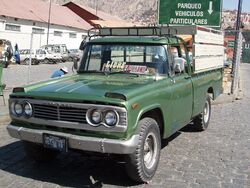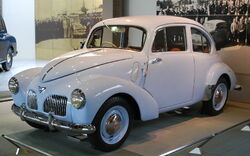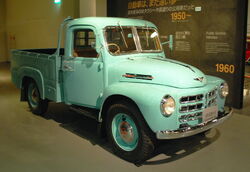The SA was Toyota's first new passenger car design (as opposed to updating the AA) after World War II. It was the first in a family of vehicles before the introduction of the Crown. A series of light trucks also shared the chassis and major components of these passenger cars.

All of these vehicles were sold under the Toyopet name.
SA[]
 | |
| Manufacturer | Toyota |
|---|---|
| Production | Oct 1947–May 1952 |
| Assembly | Japan |
| Predecessor | AE |
| Successor | SD |
| Class | large family car |
| Body style(s) | sedan |
| Layout | front-engine, rear-wheel drive |
| Platform | backbone chassis |
| Engine(s) | Type S |
| Transmission(s) | 3 speed manual |
| Wheelbase | 2400 mm[1] |
| Length | 3800 mm |
| Width | 1590 mm |
| Height | 1530 mm |
| Curb weight | 1170 kg |
| Related | SB, SC |
| Designer | Dr Kazuo Kumabe |
The SA was Toyota's first true post war design. It differed from all previous Toyota cars by having a 4 cylinder engine (previously a 6 cylinder was used), 4 wheel independent suspension (previously using rigid axles with leaf springs) and a smaller, aerodynamic body. The project was driven by Kiichiro Toyoda under the wisdom of his father's (Sakichi Toyoda) words, "Stay ahead of the times"[2] but most of the design work was done by Dr Kazuo Kumabe.[3]
The body was aerodynamic in a style similar to the Volkswagen Beetle. Only a two door sedan was made, making it unsuitable for the taxi market. The doors were arranged to open rearwards (often called suicide doors). The front window was a single pane of flat glass with a single wiper mounted above the driver. Only right hand drive was offered.
Toyota engineers (including Dr Kumabe) had visited Germany before World War II and had studied the 16 cylinder Auto Union racing car (independent suspension) and Porsche and Volkswagen designs (independent suspension, aerodynamic bodies, backbone chassis, rear mounted air cooled engines, economical production cost).[4] Many Japanese companies had ties with Germany during the war years but most partnered with British or American companies after the war and thus used technologies commonly used in Britain or America. But Toyota did not partner with a foreign company, so it was free to use German designs. Many features of the prototype Beetle were subsequently put into the SA, although the Beetle's rear mounted air cooled engine feature was not used. Later on, Toyota revisited the economic principles exemplified by the Beetle when designing the Publica and the Corolla.
Dates and Production Figures[]
Although permission to begin full production of passenger cars in Japan was not granted until 1949, limited numbers of cars were permitted to be built from 1947, and the Toyota SA was one such car.[4][5][6] Design work started at the end of 1945 when the GHQ let it be known that authorised commercial production of vehicles for the general public would be commencing soon. This model was introduced in January 1947, with a prototype (which had been under development for more than a year) being completed at that time.[2]
Production occurred from October 1947 through May 1952 (overlapping with the 1949-introduced SD), with a total of only 215 being built.[7] The first car to be produced by Toyota in the postwar period was the AC, which had first been produced in 1943-1944. Fifty were built for government and military use in 1947, and three more were assembled in 1948. Since only 54 cars were built by Toyota in 1947, this leaves four Model SA production cars to be built at the end of that year, not counting the prototype.
Eighteen SA cars were built in 1948, and from 1949–1952, 193 more were built. No breakdown exists between models after 1948; only yearly passenger-car grand totals are extant.
Mechanicals[]
This model introduced the Type S straight-4 water cooled engine, conventionally mounted in the front of the car and driving through the rear wheels. Two small grills at the front allowed air for the engine's radiator. Transmission was by a 3 speed manual gearbox and a Hotchkiss drive[4] (previous Toyotas used a torque tube) to a rear mounted differential. The final drive gear ratio was 7.17:1 .
More unconventional was the use of a backbone chassis and four wheel independent suspension. A-arm suspension (short upper arm, long lower arm) with coils was used at the front and swing axle suspension with semi-trailing arms, Panhard rods and a transverse semi-elliptical leaf spring was used at the rear.
SB[]
| Manufacturer | Toyota |
|---|---|
| Production | 1947–1952 |
| Assembly | Japan |
| Successor | SG |
| Class | light truck |
| Layout | front-engine, rear-wheel drive |
| Platform | ladder frame |
| Engine(s) | 995 cc Type S |
| Transmission(s) | 3 speed manual |
| Wheelbase | 2400 mm[1] |
| Length | 3950 mm[8] |
| Width | 1595 mm[8] |
| Height | 1800 mm[8] |
| Curb weight | 1050 kg[8] |
| Related | SA, SC |
A light truck using the running gear from the SA but with a ladder chassis and solid axles front and rear, both with semi-elliptical springs. The SB was popular with the general public and also with the American occupation forces, which ordered it in large numbers.[4]
The SB was offered with commercial bodies only but many dealers and owners had sedan bodies made for them.[2][4] Toyota contracted the Kanto Denki factory to produced a sedan body and wagon on the SB chassis as the SC.
A small number of police cars were made by adding a special body with a canvas top, 4 canvas doors and a fold down front window for the Japanese Police Reserve Force but they were not popular.[9]
Dates and Production Figures[]
Produced from 1947.
Mechanicals[]
The SB used the same engine and gearbox as the SA, a three-speed manual and the 1-litre "S"-series engine, producing 27 PS (20 kW) at 4,000 rpm. This was enough for a top speed of 68 km/h (42 mph).[10] A conventional ladder frame chassis was used with conventional semi-elliptical springs and solid axles front and rear.
SC[]
| Manufacturer | Toyota |
|---|---|
| Production | 3 prototypes in 1948 |
| Assembly | Japan |
| Predecessor | SA |
| Successor | SD |
| Class | large family car |
| Body style(s) | sedan |
| Layout | front-engine, rear-wheel drive |
| Platform | ladder frame |
| Engine(s) | Type S |
| Transmission(s) | 3 speed manual |
| Related | SB |
The SB light truck was offered with commercial bodies only but many dealers and owners had sedan bodies made for them.[2][4] Toyota contracted the Kanto Denki factory to produced a 4-door, 4-seat sedan body and wagon on the SB chassis as the SC.[11] However, production of the SA sedan continued and the SC was not put into production. When production of the SA stopped, a revised version of the SC was made as the SD.
Dates and Production Figures[]
3 prototypes were built but the SC did not go into production.[12]
Mechanicals[]
Same as the SB except for independent front suspension.[11]
SD[]
| Manufacturer | Toyota |
|---|---|
| Production | Nov 1949–1951 |
| Assembly | Japan |
| Predecessor | SA |
| Successor | SF |
| Class | family car |
| Body style(s) | sedan |
| Layout | front-engine, rear-wheel drive |
| Platform | ladder frame |
| Engine(s) | Type S |
| Transmission(s) | 3 speed manual |
| Related | SB |
A 5-seater passenger car using the same chassis and suspension as the SB.[12]
Dates and Production Figures[]
Produced from November 1949 to 1951.
Mechanicals[]
Same as the SB.
SF[]
| Manufacturer | Toyota |
|---|---|
| Production | Oct 1951–1953 |
| Assembly | Japan |
| Predecessor | SD |
| Successor | RH |
| Class | large family car |
| Body style(s) | sedan |
| Layout | front-engine, rear-wheel drive |
| Platform | ladder frame |
| Engine(s) | Type S |
| Transmission(s) | 3 speed manual |
| Wheelbase | 2500 mm[1] |
| Length | 4280 mm |
| Width | 1590 mm |
| Height | 1600 mm |
| Curb weight | 1250 kg |
| Related | SG |
An update to the SD.
Dates and Production Figures[]
Produced from October 1951[2] to 1953.
Mechanicals[]
Same as the SD.
SG[]
 | |
| Manufacturer | Toyota |
|---|---|
| Production | Mar 1952–1954 |
| Assembly | Japan |
| Predecessor | SB |
| Successor | SK |
| Class | light truck |
| Layout | front-engine, rear-wheel drive |
| Platform | ladder frame |
| Engine(s) | Type S |
| Transmission(s) | 3 speed manual |
| Wheelbase | 2500 mm[1] |
| Length | 4195 mm |
| Width | 1595 mm |
| Height | 1735 mm |
| Curb weight | 1170 kg |
An update to the SB, sharing components with the SF.
Dates and Production Figures[]
Produced from March 1952[11] to 1954.
Mechanicals[]
Same as the SF.
RH[]
 | |
| Manufacturer | Toyota |
|---|---|
| Also called | Super |
| Production | Sep 1953–1955 |
| Assembly | Japan |
| Predecessor | SF |
| Successor | RR |
| Class | large family car |
| Body style(s) | sedan |
| Layout | front-engine, rear-wheel drive |
| Platform | ladder frame |
| Engine(s) | Type R |
| Related | FHJ, FH24 |
A further update to the SF but with the newly designed Type R engine.[11] The RHN's body was made by the New Mitsubishi Heavy Industrial Manufacturing Co. and the RHK's body was made by Kanto Auto Work, Ltd.[13]
The RH was also made into BH26 Police Patrol Car and the BH28 Ambulance by using the Type B 6 cylinder engine and a longer front end. The RH was succeeded by the similar 1955 RR Master and the much more modern 1955 RS Crown.
The RH was also known as the Super.
Dates and Production Figures[]
Produced from September 1953 to 1955.
Mechanicals[]
Same as the SF except for the new Type R engine.
FHJ[]
| Manufacturer | Toyota |
|---|---|
| Assembly | Japan |
| Successor | FH24 |
| Class | light truck |
| Body style(s) | fire appliance |
| Layout | front-engine, rear-wheel drive |
| Platform | ladder frame |
| Engine(s) | Type F |
| Length | 4540 mm |
| Width | 1680 mm |
| Height | 1870 mm |
| Curb weight | 965 kg |
| Related | RH |
The FHJ was a fire appliance vehicle built based on the RH but with the much larger Type F engine. [14] This was sold at the same time as the FAJ (based on the heavy duty FA truck), the FCJ (based on the medium duty FC truck) and the FJJ (based on the BJ Jeep).
Mechanicals[]
Same as the RH except for the Type F engine. The front body was based on the SG light truck, there were no doors and the rear of the body was heavily customised with typical fire appliance accessories (e.g. hoses, axes, ride-on steps, grab bars). In spite of looking like a small truck, the FHJ still used the single rear wheels of the RH passenger car.
FH24[]
 | |
| Manufacturer | Toyota |
|---|---|
| Assembly | Japan |
| Predecessor | FHJ |
| Class | light truck |
| Body style(s) | fire appliance |
| Layout | front-engine, rear-wheel drive |
| Platform | ladder frame |
| Engine(s) | Type F |
| Related | RH |
The FH24 was a fire appliance vehicle built based on the RH but with the much larger Type F engine.[15] It was very similar to the earlier FHJ fire appliance.
Mechanicals[]
Same as the RH except for the Type F engine. The front body was based on the SG light truck, there were no doors and the rear of the body was heavily customised with typical fire appliance accessories (e.g. hoses, axes, ride-on steps, grab bars). In spite of looking like a small truck, the FH24 still used the single rear wheels of the RH passenger car.
RR[]
 | |
| Manufacturer | Toyota |
|---|---|
| Also called | Master |
| Production | Jan 1955–Nov 1956 |
| Assembly | Japan |
| Predecessor | RH |
| Successor | Crown RS |
| Class | large family car |
| Body style(s) | sedan |
| Layout | front-engine, rear-wheel drive |
| Platform | ladder frame |
| Engine(s) | Type R |
| Related | Crown RS |
The RR Master (Japanese: ja:トヨペット・マスター) was a further update to the SF/RH with an updated body.
The RS Crown was designed to replace the Super in 1955 but Toyota wasn't sure if its independent front coil suspension and its suicide type rear doors were too radical for the taxi market to bear. So the Super was updated, renamed the Master and sold alongside the Crown. When sales of the Crown proved worthwhile, the RR Master was discontinued in November 1956. Production facilities for the Master were transferred to the Crown.[11]
The Toyopet Master range also included the Master RR16 pickup, the Master RR17 van and the Master RR19 double pickup (with two rows of seats).[16] These replaced the SG.
The RR Master's body panels were used in cut-down form as an economical and fast way to design the new ST10 Corona in 1957. A later variant of the Crown was called the Masterline to distinguish it from other variants of the Crown.
Dates and Production Figures[]
Produced from January 1955 to November 1956.
Mechanicals[]
Same as the RH.
Timeline[]
| Toyota road car timeline, 1935–1954 next » | ||||||||||||||||||||||
|---|---|---|---|---|---|---|---|---|---|---|---|---|---|---|---|---|---|---|---|---|---|---|
| Type | 1930s | 1940s | 1950s | |||||||||||||||||||
| Model year | 5 | 6 | 7 | 8 | 9 | 0 | 1 | 2 | 3 | 4 | 5 | 6 | 7 | 8 | 9 | 0 | 1 | 2 | 3 | 4 | ||
| Mid-size | SA | |||||||||||||||||||||
| SD | SF | RH | ||||||||||||||||||||
| Full-size | A1 | AA/AB | AC | AC | ||||||||||||||||||
| BA | AE | |||||||||||||||||||||
References[]
| This page uses some content from Wikipedia. The original article was at Toyota SA. The list of authors can be seen in the page history. As with Tractor & Construction Plant Wiki, the text of Wikipedia is available under the Creative Commons by Attribution License and/or GNU Free Documentation License. Please check page history for when the original article was copied to Wikia |
- ↑ 1.0 1.1 1.2 1.3 "The Japanese Automobile Industry: Technology and Management at Nissan & Toyota", Michael Cusumano, Cambridge (Mass.) & London: The Harvard Univ. Press, 1985, ISBN 067447256X
- ↑ 2.0 2.1 2.2 2.3 2.4 "Toyota: Fifty Years in Motion", Eiji Toyoda, Tokyo: Kodansha International, 1987, ISBN 0-87011-823-4, p119
- ↑ "Fifty Years of Toyota Concept Cars", in "the wheel extended", vol 17, no.3, 1987, Toyota Motor Corporation, ISSN 0049-755X
- ↑ 4.0 4.1 4.2 4.3 4.4 4.5 "Autos Made in Japan", Jan P. Norbye, Gerlingen: Bleicher Verlag, 1991, ISBN 3-88350-161-1
- ↑ "The Complete History of the Japanese Car", Marco Ruiz, New York: Portland House, 1986, ISBN 0-517-61777-3
- ↑ "Toyota seit 1936", Joachim Kuch, Stuttgart: Motorbuch Verlag, Artikelnummer 17060
- ↑ "The New Encyclopedia of Motorcars: 1885 to the Present", G. N. Georgano, New York: E. P. Dutton, 3rd revised ed., 1982, ISBN 0-525-93254-2
- ↑ 8.0 8.1 8.2 8.3 Ozeki, Kazuo (2007).
日本のトラック・バス 1917~1975 (in Japanese). Tokyo: Miki Press, 86. ISBN 978-4-89522-487-1. - ↑ "Old Iron" column, February 2005, in the "Off Road Adventures" online magazine, http://www.oramagazine.com/pastIssues/0502-issue/050215d-old-iron.html
- ↑ Ozeki, Kazuo, Japanese Trucks and Buses 1917-1975, p. 45
- ↑ 11.0 11.1 11.2 11.3 11.4 "Toyota: A history of the First 50 Years", Toyota Motor Corporation, 1988, ISBN 0-517-61777-3
- ↑ 12.0 12.1 "Senchu University bulletin 84-4 - The distribution of the car immediately after World War II (2)" (PDF). Retrieved on 2009-05-03.
- ↑ "Toyota Automobile Museum", http://www.toyota.co.jp/Museum/data_e/a03_08_5.html#2
- ↑ "Toyota Fire Engine", Toyota brochure No. 323, Japan
- ↑ "FH24 at Toyota Automobile Museum". Retrieved on 2009-03-10.
- ↑ マスターライン
- Toyota history web page, 1940–1949, http://www.toyota.co.jp/en/history/1940.html
- Toyota history web page, 1950–1959, http://www.toyota.co.jp/en/history/1950.html